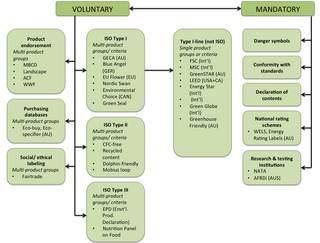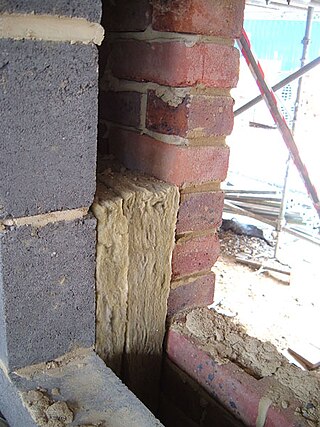
Energy Star is a program run by the U.S. Environmental Protection Agency (EPA) and U.S. Department of Energy (DOE) that promotes energy efficiency. The program provides information on the energy consumption of products and devices using different standardized methods. The Energy Star label is found on more than 75 different certified product categories, homes, commercial buildings, and industrial plants. In the United States, the Energy Star label is also shown on the Energy Guide appliance label of qualifying products.

Ecolabels and Green Stickers are labeling systems for food and consumer products. The use of ecolabels is voluntary, whereas green stickers are mandated by law; for example, in North America major appliances and automobiles use Energy Star. They are a form of sustainability measurement directed at consumers, intended to make it easy to take environmental concerns into account when shopping. Some labels quantify pollution or energy consumption by way of index scores or units of measurement, while others assert compliance with a set of practices or minimum requirements for sustainability or reduction of harm to the environment. Many ecolabels are focused on minimising the negative ecological impacts of primary production or resource extraction in a given sector or commodity through a set of good practices that are captured in a sustainability standard. Through a verification process, usually referred to as "certification", a farm, forest, fishery, or mine can show that it complies with a standard and earn the right to sell its products as certified through the supply chain, often resulting in a consumer-facing ecolabel.

A low-energy house is characterized by an energy-efficient design and technical features which enable it to provide high living standards and comfort with low energy consumption and carbon emissions. Traditional heating and active cooling systems are absent, or their use is secondary. Low-energy buildings may be viewed as examples of sustainable architecture. Low-energy houses often have active and passive solar building design and components, which reduce the house's energy consumption and minimally impact the resident's lifestyle. Throughout the world, companies and non-profit organizations provide guidelines and issue certifications to guarantee the energy performance of buildings and their processes and materials. Certifications include passive house, BBC - Bâtiment Basse Consommation - Effinergie (France), zero-carbon house (UK), and Minergie (Switzerland).

Passive house is a voluntary standard for energy efficiency in a building, which reduces the building's ecological footprint. It results in ultra-low energy buildings that require little energy for space heating or cooling. A similar standard, MINERGIE-P, is used in Switzerland. The standard is not confined to residential properties; several office buildings, schools, kindergartens and a supermarket have also been constructed to the standard. The design is not an attachment or supplement to architectural design, but a design process that integrates with architectural design. Although it is generally applied to new buildings, it has also been used for refurbishments.
The Nationwide House Energy Rating Scheme (NatHERS) is a national scheme to measure the energy efficiency of a residential dwelling in Australia. An accredited software tool assesses the home based on a variety of criteria and produces an energy star rating.
Renewable heat is an application of renewable energy referring to the generation of heat from renewable sources; for example, feeding radiators with water warmed by focused solar radiation rather than by a fossil fuel boiler. Renewable heat technologies include renewable biofuels, solar heating, geothermal heating, heat pumps and heat exchangers. Insulation is almost always an important factor in how renewable heating is implemented.

A cavity wall is a type of wall that has a hollow center. They can be described as consisting of two "skins" separated by a hollow space (cavity). The skins typically are masonry, such as brick or cinder block. Masonry is an absorbent material that can slowly draw rainwater or even humidity into the wall. One function of the cavity is to drain water through weep holes at the base of the wall system or above windows. The weep holes allow wind to create an air stream through the cavity that exports evaporated water from the cavity to the outside. Usually, weep holes are created by separating several vertical joints approximately two meters apart at the base of each story. Weep holes are also placed above windows to prevent dry rot of wooden window frames. A cavity wall with masonry as both inner and outer skins is more commonly referred to as a double wythe masonry wall.
Domestic housing in the United Kingdom presents a possible opportunity for achieving the 20% overall cut in UK greenhouse gas emissions targeted by the Government for 2010. However, the process of achieving that drop is proving problematic given the very wide range of age and condition of the UK housing stock.

Building insulation is material used in a building to reduce the flow of thermal energy. While the majority of insulation in buildings is for thermal purposes, the term also applies to acoustic insulation, fire insulation, and impact insulation. Often an insulation material will be chosen for its ability to perform several of these functions at once.
The Low Carbon Building Programme (LCBP) was a payments system in England, Scotland and Wales. The UK Government programme was administered by BERR and ran from 1 April 2006 until its closure to new applications on 24 May 2010. The scheme was replaced by the Renewable Heat Incentive in November 2011.
Minergie is a registered quality label for new and refurbished low-energy-consumption buildings. This label is mutually supported by the Swiss Confederation, the Swiss Cantons and the Principality of Liechtenstein along with Trade and Industry. The label is registered in Switzerland and around the world and is thus protected against unlicensed use. The Minergie label may only be used for buildings, services and components that actually meet the Minergie standard.
The Code for Sustainable Homes was an environmental assessment method for rating and certifying the performance of new homes in United Kingdom. First introduced in 2006, it is a national standard for use in the design and construction of new homes with a view to encouraging continuous improvement in sustainable home building. In 2015 the Government in England withdrew it, consolidating some standards into Building Regulations.

An energy audit is an inspection survey and an analysis of energy flows for energy conservation in a building. It may include a process or system to reduce the amount of energy input into the system without negatively affecting the output. In commercial and industrial real estate, an energy audit is the first step in identifying opportunities to reduce energy expense and carbon footprint.
Energy Saving Trust (EST) is a British organization devoted to promoting energy efficiency, energy conservation, and the sustainable use of energy, thereby reducing carbon dioxide emissions and helping to prevent man-made climate change. It was founded in the United Kingdom as a government-sponsored initiative in 1992, following the global Earth Summit.

The National Energy Foundation (NEF) is an independent British charity, established to improve the use of energy in buildings.

Solar hot water is water heated using only energy from the Sun. Solar energy heats up large panels called thermal collectors commonly known as solar panels. The energy is transferred through a fluid to a reservoir tank for storage and subsequent use. It is then used to heat water for commercial or domestic use and also as an energy input for heating and cooling devices and for industrial 'process heat' applications. In domestic solar hot water applications, the thermal collectors can either be coupled together with the hot water storage tank on a rooftop, or separated from the storage tank, in a "split system" configuration.

An Eco-house (or Eco-home) is an environmentally low-impact home designed and built using materials and technology that reduces its carbon footprint and lowers its energy needs. Eco-homes are measured in multiple ways meeting sustainability needs such as water conservation, reducing wastes through reusing and recycling materials, controlling pollution to limit global warming, energy generation and conservation, and decreasing CO2 emissions.
Mark Group Limited is a UK based energy advice and installation company, who focus upon energy efficiency. Mark Group went into administration on 7 October 2015. They work with homeowners, businesses, housebuilders and the construction industry, local authorities and social housing providers. Mark Group operates out of 17 locations throughout England, Scotland and Wales. Its head office is based in Leicester, East Midlands, where approximately 500 of its staff operate.
The Green Deal was a UK government policy initiative that gave homeowners, landlords and tenants the opportunity to pay for energy efficient home improvements through the savings on their energy bills from 2012 to 2015. At the heart of the Green Deal was the rule that savings on bills would exceed the cost of the work. By meeting this 'Golden Rule', consumers were able to receive energy savings without direct cost. Consumers then paid back the cost of such improvements through the expected savings in their energy bills. However, there is no guarantee that the eventual savings made by consumers will match the cost of the loans they take out to make the improvements and industry bodies recognised there was a risk consumers could end up out of pocket.
The house energy rating (HER) is a standard measure of comparison by which one can evaluate the energy efficiency of a new or an existing building. The comparison is generally done for energy requirements for heating and cooling of indoor space. The energy is the main criterion considered by any international building energy rating scheme but there are some other important factors such as production of greenhouse gases emission, indoor environment quality, cost efficiency and thermal comfort, which are considered by some schemes. Basically, the energy rating of a residential building provides detailed information on the energy consumption and the relative energy efficiency of the building. Hence, HERs inform consumers about the relative energy efficiency of homes and encourage them to use this information in making their house purchase decision. There are many energy rating tools by which one can calculate the energy performance of a building. Basically all these tools involve a numerical description or prepare a computer-based model for the rating of a building against standard occupancy and activity templates. So, HERS uses a computer-simulation based methods for assessing the energy efficiency of buildings under standard conditions and its potential for improvement.










